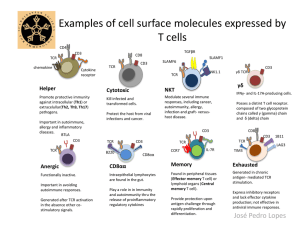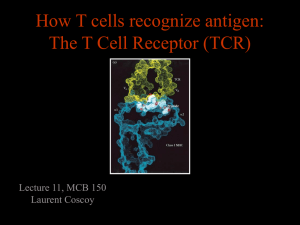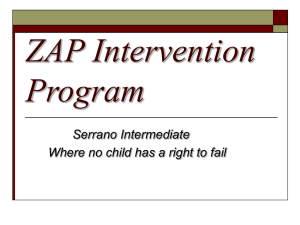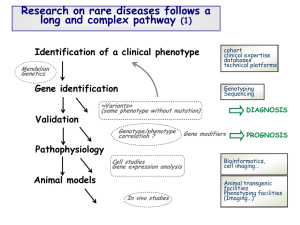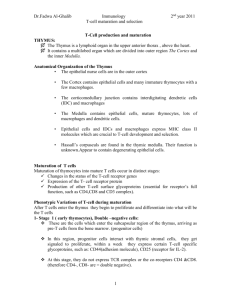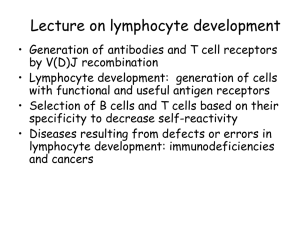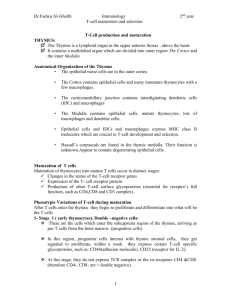Document
advertisement
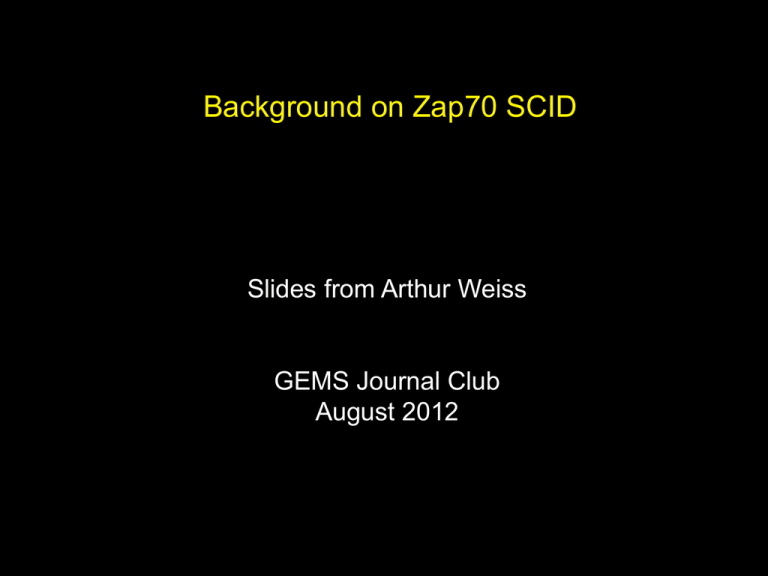
Background on Zap70 SCID Slides from Arthur Weiss GEMS Journal Club August 2012 Case Presentation A 1 year old Hispanic female was referred to UCSF for the possibility of a bone marrow transplantation. She had a history of: recurrent pneumonias chronic gastroenteritis failure to thrive oral/cutaneous candidiasis history of disseminated varicella Her parents were first cousins. One of her three sibs (brother) died at age 9 months. Physical Exam was unremarkable Laboratory Evaluation • B cell number: Normal • Immunoglobulin levels: Decreased IgM, IgG and IgA • Abnormal lymphocyte phenotype: CD3 76%; CD4 74%; CD8 0-2% • T cells are polyclonal • In vitro proliferation studies: B cells proliferate normally to mitogens CD4 T cells: Fail to respond to PHA or anti-CD3 mAb Positive proliferative response to IL-2 Positive proliferative response to PMA plus ionomycin Severe Combined Immunodeficiency Syndrome SCID • Primary Defect - Absent T cell function - Variable T cell counts (absent to elevated) • Associated Defects - Decreased B cell responses (intrinsic or extrinsic) - Variable B cell counts (often normal) Multiple Molecular Causes of SCID • X-linked Common chain (IL-2, IL-4, IL-7, IL-9, and IL-15 receptors) - 50% • Jak 3 tyrosine kinase • IL-7 receptor alpha chain • Adenosine Deaminase (ADA) • Purine Nucleoside Phosphorylase (PNP) • Recombinase Activating Genes (Rag 1 and Rag 2) • CD3 and • CD45 tyrosine phosphatase • Bare lymphocyte syndrome (absent MHC molecules) • ZAP-70 tyrosine kinase Causes of severe T cell deficiency QuickTime™ and a decompressor are needed to see this picture. Liston, Enders, Siggs NRI, 2008 Unusual Phenotype of ZAP-70 Deficient SCID: Absence of Peripheral CD8 T Cells Chan, et al., Science, 1994 ZAP-70 Deficient CD4 T Cells Fail to Signal in Response to TCR Stimulation Chan, et al., Science, 1994 Patient TCR Stimulation Western Blot antiphosphotyrosine Normal ZAP-70 Mutations Accounting for SCID What is the Function of ZAP-70? TCR Signaling is Initiated by Coordinated Actions of Two Cytoplasmic Tyrosine Kinases: Lck and ZAP-70 Wang, et al, CSHL, 2009 How Does the Absence of ZAP-70 Affect T cell Development ? A Brief Introduction to T Cell Development T Cell Developmental Checkpoints pre-TCR CD4CD8TCR - CD4CD8pTCR + TCR CD4 SP CD4+ CD8TCR high DP CD4+ CD8+ TCR low CD4CD8+ TCR high Pre-TCR selection r ag CD3 TCR p r e- T lck/ f y n ZA P-7 0 / Sy k Positive & Negative TCR Selection MHC class I MHC class II 2 microglobulin CD8 SP CD4 DN CD8 CD8 block only CD4 block only CD8 block only CD4 ZAP 70 KO ZAP 70 KOin ZAP 70 K Complete T cellWTDevelopmental Arrest A SLAP and c- Cbl both partially rescue x SLAPthe KO ZAP-70 x c-Cbl K ZAP-70 Deficient Mice 0.8 2.5 4.7 T hymocytes 7.8 WT ZAP 70 KO ZAP 70 KO ZAP 70 K A Normal 1.2 ZAP-70 KO 7.8 x SLAP KO 0.2 0.8 x c-Cbl K 0.7 2.5 4.7 CD4 CD8 Thymocytes CD4 LN T cells B WT 1.2 0.2 ZAP 70 KO 0.7 ZAP 70 KO x SLAP KO ZAP 70 K x c-Cbl K CD8 32.4 CD4 LN T cells BCD4 1.1 WT ZAP 70 KO 18.4 32.4 CD4 2.7 Lymph node cells ZAP 70 KO ZAP 70 K x SLAP KO x c-Cbl K 0.4 1.1 CD8 2.8 0.1 2.7 2.8 CD8 Decreased Function of ZAP-70 Can Lead to Autoimmunity Spontaneous Development of Erosive Arthritis in SKG mice Sakaguchi, et al, Nature, 2003 • Incidental finding in Balb/c mouse colony • 100% penetrant, males and females affected • Onset at 2 months (joint swelling and hyperemia) or following activation of the innate immune response • Interphalangeal joints -> symmetrical involvement including wrist and ankle joints. Spares large joints and spine (except base of tail) Destruction of joint space. • RF+, mediated by CD4 T cells Hypomorphic Mutant Allele of ZAP-70 with Decreased Catalytic Activity Associated with ANA Positive Autoimmunity in Mice Siggs, et al., Immunity, 2007 Thymocyte selection is dependent on signaling through the TCR Signal strength Signal strength = Affinity X TCR signaling intensity Thymocyte selection is dependent on signaling through the TCR Decreasing TCR Signaling by ZAP-70 mutation alters the TCR repertoire of thymocytes surviving both positive and negative selection Signal strength Signal strength = Affinity X TCR Signaling Intensity Asymmetric effects on immunogenic and tolerogenic TCR signaling may account for autoimmunity with partial immunodeficiency QuickTime™ and a decompressor are needed to see this picture. Liston, Enders, Siggs NRI, 2008

